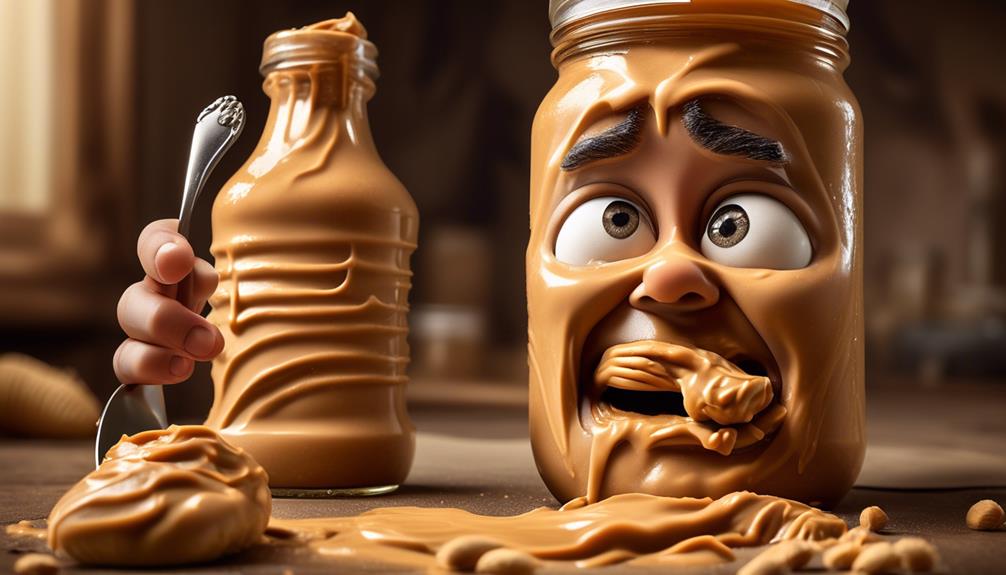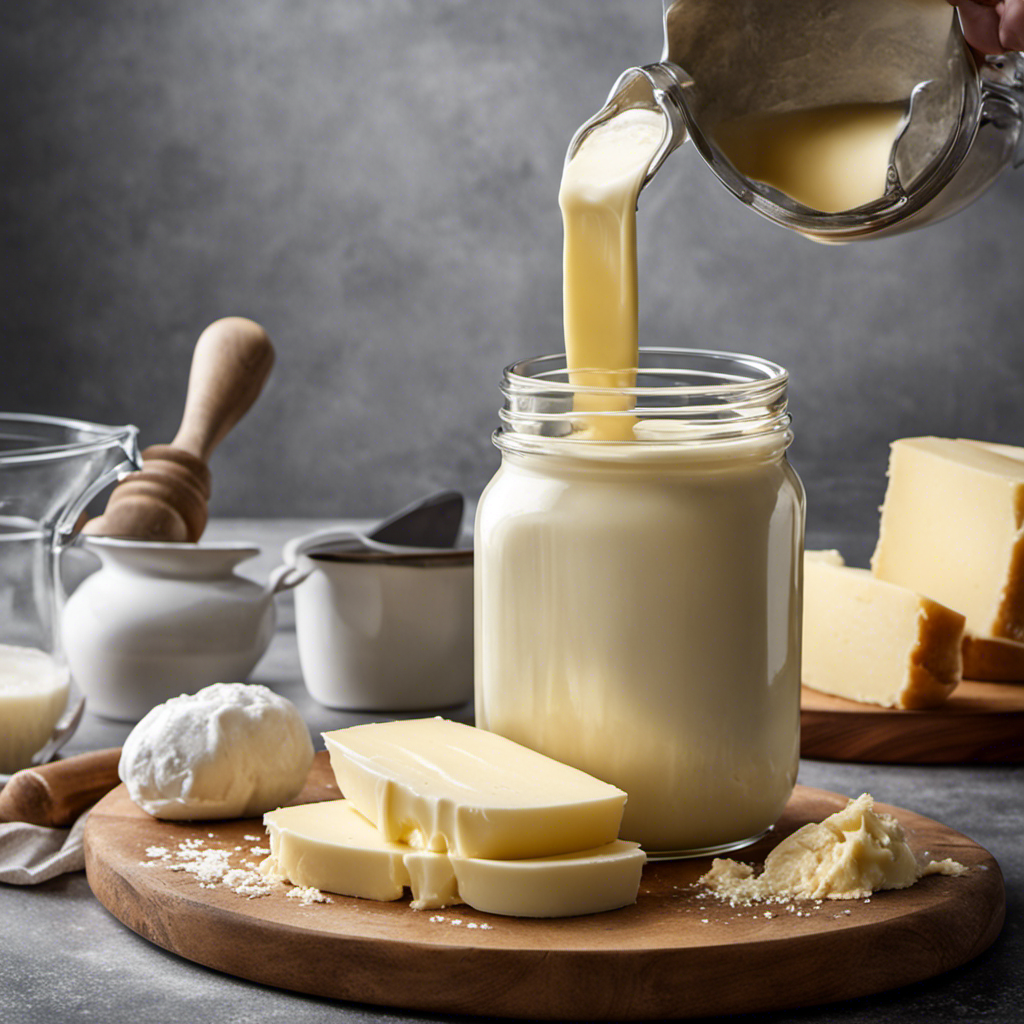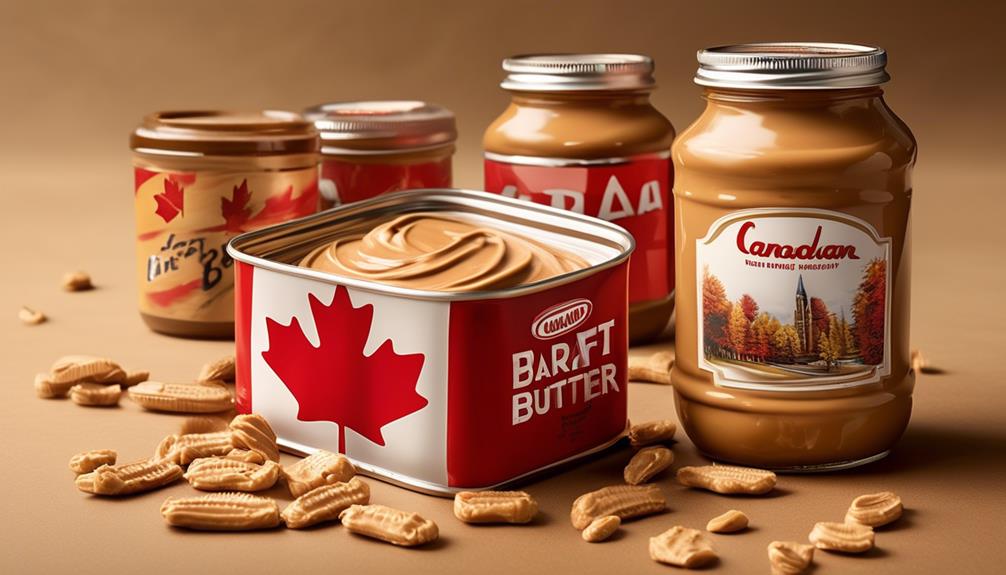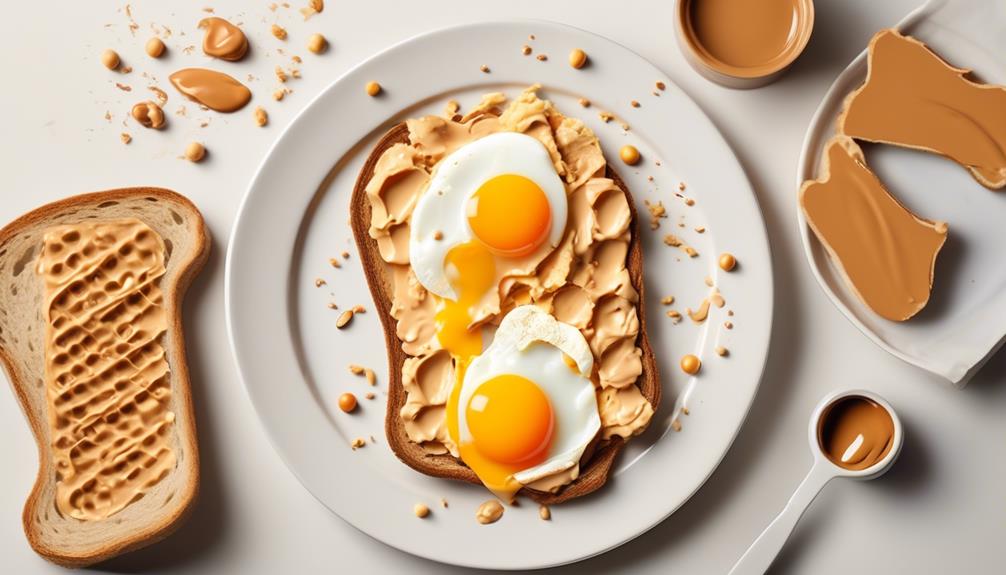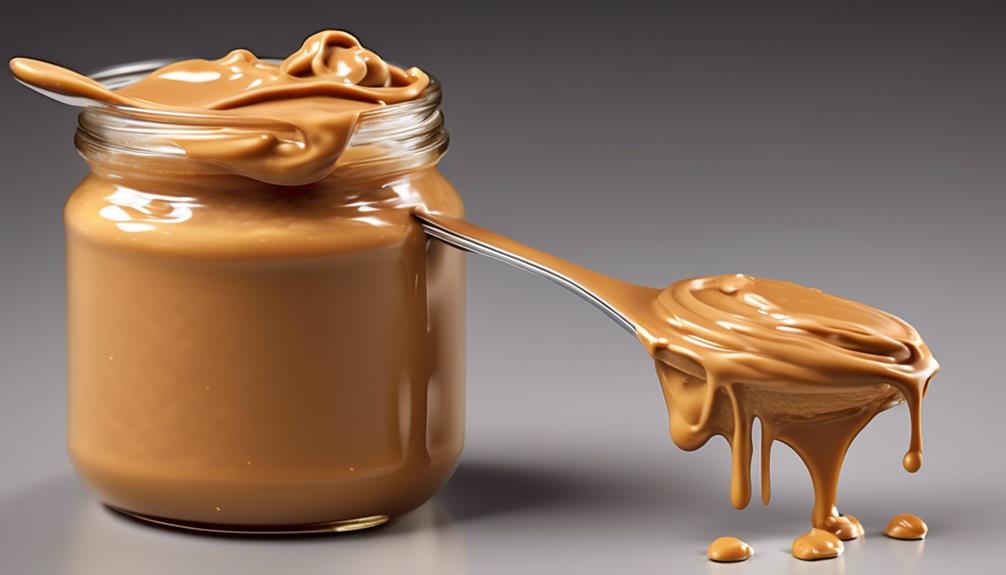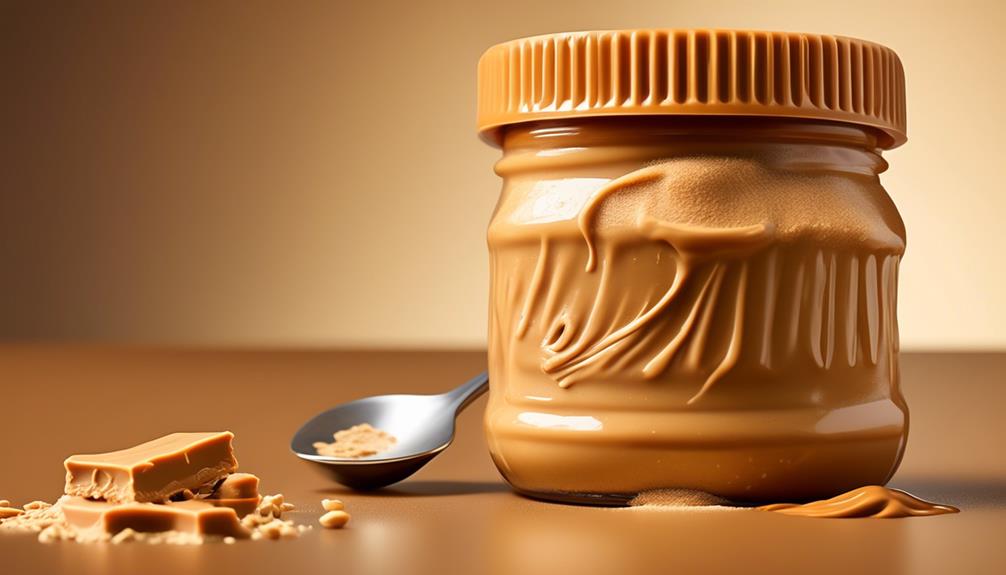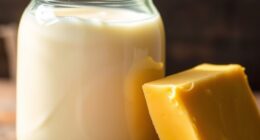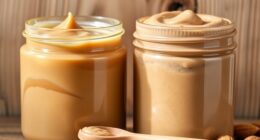We’ve all had that experience when we bite into peanut butter and it doesn’t taste quite like it should.
But have you ever wondered why peanut butter can sometimes taste bad?
There are actually several factors that can contribute to this less-than-pleasant experience, and understanding them might just change the way you look at your favorite spread.
Key Takeaways
- Different factors can affect the taste of peanut butter, including the perception of flavors by different taste buds and the roasting process.
- Improper storage conditions, such as exposure to air or high temperatures, can cause the oils in peanuts to become rancid and contribute to a bad taste.
- Over-roasting or using old and stale peanuts can result in burnt flavors and increased bitterness in peanut butter.
- The use of hydrogenated oils, additives, and mold-contaminated peanuts can introduce unwanted flavors and bitterness to peanut butter.
The Role of Taste Buds
The taste buds play a crucial role in our ability to perceive and distinguish different flavors, allowing us to experience the complex and varied sensations of taste.
When it comes to the peanut butter taste, the taste buds are particularly important. Peanuts, the main ingredient in peanut butter, contain a mix of flavors that can be perceived differently depending on the individual's taste buds.
The sweetness of peanuts can be sensed by the taste buds located at the tip of the tongue, while the saltiness may be detected on the sides. Additionally, the rich, nutty flavor of peanuts is a result of the combination of various compounds that interact with the taste buds, providing a unique taste experience.
However, some individuals may perceive a bitter undertone in peanut butter, which can be attributed to the sensitivity of taste buds located at the back of the tongue. These taste buds are particularly responsive to bitter flavors, and their sensitivity varies among individuals, influencing how peanut butter taste is perceived.
Bitterness in Peanuts

When it comes to the bitterness in peanuts, the roasting process plays a crucial role. The natural oils found in peanuts can turn rancid when exposed to improper storage conditions, leading to a bitter taste.
Additionally, over-roasting peanuts can result in burnt flavors, contributing to the bitterness in peanut butter.
Roasting Process
During the roasting process, it is essential to carefully monitor the peanuts to prevent over-roasting and the development of bitterness in the resulting peanut butter. Over-roasting the peanuts can lead to a burnt flavor, imparting bitterness to the peanut butter. Additionally, improper storage of peanuts can cause their oils to go rancid, contributing to bitterness during the roasting process. Moreover, the use of old or stale peanuts for roasting can intensify the bitter taste in the final product. To prevent bitterness, it is crucial to opt for high-quality, fresh peanuts and avoid over-roasting. Proper storage of peanuts in a cool, dry place can also help maintain their freshness and prevent bitterness during the roasting process. Below is a table summarizing key factors influencing the bitterness in peanut butter during the roasting process.
| Factors contributing to bitterness in peanut butter | |
|---|---|
| Over-roasting the peanuts | Burnt flavor leading to bitterness |
| Rancid oil | Improperly stored peanuts result in bitterness |
| Stale nuts | Use of old or stale peanuts intensifies bitterness |
| Preventing bitterness | Opt for high-quality, fresh peanuts and avoid over-roasting |
| Proper storage | Storing peanuts in a cool, dry place helps maintain freshness and prevent bitterness |
Natural Peanut Oils
Transitioning from the discussion on the roasting process, we can now explore the impact of natural peanut oils on the bitterness in peanuts and peanut butter.
Natural oils in peanuts play a crucial role in determining the flavor profile of peanut butter. When peanuts are stored improperly, the natural oils can become rancid, resulting in a bitter taste in the peanut butter.
Additionally, the quality of the peanuts used in the production of peanut butter is essential, as stale or old peanuts can also contribute to bitterness. Over-roasting peanuts can lead to the production of burnt oils, further intensifying the bitter taste in peanut butter.
It's important to note that the presence of these natural oils is what gives peanut butter its distinctive taste, and their quality and freshness significantly impact how peanut butter tastes.
Impact of Processing Methods

When considering the impact of processing methods on peanut butter taste, the duration and temperature of roasting are critical factors. These conditions can lead to chemical changes in the peanuts, affecting the overall flavor profile.
Additionally, the grinding process and oil extraction methods play a vital role in determining the taste and quality of the final product.
Impact of Roasting
Roasting significantly impacts the flavor profile, aroma compounds, nutritional composition, texture, and shelf-life of peanuts, ultimately influencing the quality of the resulting peanut butter product.
The taste of peanuts is enhanced through the roasting process, as it brings out their nutty and earthy notes, creating a more robust and desirable flavor.
Additionally, the aroma compounds developed during roasting contribute to a richer and more complex sensory experience, evoking feelings of comfort and satisfaction.
Furthermore, the texture of the peanuts is modified, resulting in a smoother, creamier consistency in the peanut butter, which can evoke a sense of indulgence and pleasure.
Chemical Changes
The chemical changes that occur during the processing of peanuts and the creation of peanut butter play a significant role in influencing the taste and quality of the final product. Different processing methods can lead to varying chemical changes, impacting the flavor profile of peanut butter. Below is a table highlighting the impact of processing methods on the chemical composition and taste of peanut butter:
| Processing Method | Chemical Change |
|---|---|
| Roasting duration | Over-roasting can lead to bitterness |
| Oxidation of oils | Rancid or bitter taste |
| Additives and preservatives | Alter chemical composition |
Understanding these chemical changes is crucial in maintaining the desired flavor profile of peanut butter. It is essential to carefully consider the processing methods to ensure that peanut butter has gone through minimal alterations, resulting in a more enjoyable taste.
Chemical Compounds in Peanut Butter

Chemical compounds present in peanut butter can significantly influence its taste and quality. Factors such as oxidized oils, Maillard reaction products, aflatoxins, hydrogenated oils, and added preservatives and stabilizers contribute to the overall flavor profile.
Oxidized oils, resulting from improper storage, can lead to a rancid and bitter taste in peanut butter. Over-roasting peanuts can produce Maillard reaction products, which contribute to a bitter taste. Mold-contaminated peanuts can produce aflatoxins, further contributing to the bitterness.
Additionally, the presence of hydrogenated oils and certain additives can introduce unwanted flavors and bitterness to peanut butter.
These chemical compounds play a crucial role in determining the taste of peanut butter, highlighting the importance of proper storage, processing, and ingredient selection to maintain the desired flavor profile in peanut butters.
The knowledge of how chemical compounds affect the taste of peanut butter is crucial for producing high-quality products. Understanding the impact of these compounds can help consumers make informed choices about the peanut butters they purchase. Proper handling and processing of peanuts can significantly influence the overall taste and quality of peanut butter, enhancing the consumer's experience.
Influence of Storage Conditions

Storing peanut butter in optimal conditions is crucial for preserving its flavor and quality, with factors such as temperature control, air exposure, and refrigeration playing key roles in maintaining its shelf life.
The influence of storage conditions on peanut butter is significant. Temperature control is essential, as storing peanut butter in a cool, dark place helps prevent rancidity and maintains its flavor.
Limiting air exposure by sealing the jar tightly and using clean utensils can prevent oxidation and spoilage of peanut butter.
Refrigeration can extend the shelf life, especially for natural varieties without stabilizers.
It's important to note that different types of peanut butter have varying shelf lives, and checking the best-by date on the packaging is crucial.
For powdered peanut butter, storing it in a cool, dry, and dark place can help maintain its quality and extend its shelf life.
Understanding and implementing proper storage conditions can significantly impact the overall taste and longevity of peanut butter, ensuring a better culinary experience for consumers.
Individual Sensitivity to Taste

Exploring the intricate interplay between individual taste sensitivity and peanut butter's flavor profile reveals a complex and nuanced relationship that extends beyond the realm of storage conditions. When it comes to peanut butter, individual sensitivity to taste plays a pivotal role in shaping one's perception of its flavor. Genetic factors significantly contribute to these differences, as they can influence how we perceive the taste of peanut butter.
Moreover, personal experiences, especially during childhood, can also mold our sensitivity to taste, impacting how we interpret the flavor of peanut butter. Additionally, health conditions and allergies can further heighten or diminish one's sensitivity to the taste of peanut butter, altering their experience with this popular spread.
- Our unique genetic makeup can significantly impact how we perceive the taste of peanut butter, creating a diverse array of experiences.
- Childhood experiences with certain flavors and textures can shape our sensitivity to taste, influencing our relationship with peanut butter.
- Health conditions and allergies can dramatically alter our sensitivity to the taste of peanut butter, impacting our enjoyment of this beloved spread.
Nutritional Factors

Peanut butter is a rich source of essential nutrients, including high levels of protein, heart-healthy fats, dietary fiber, and vital micronutrients such as vitamin E, magnesium, and potassium.
Protein, an important macronutrient, aids in muscle repair and growth, making peanut butter a valuable addition to a balanced diet.
The presence of healthy monounsaturated and polyunsaturated fats in peanut butter contributes to its positive impact on heart health.
Furthermore, the dietary fiber found in peanut butter supports digestive health and promotes a feeling of fullness, making it a satisfying food choice.
Additionally, the micronutrients present in peanut butter, such as vitamin E, magnesium, and potassium, play various roles in maintaining overall health and well-being.
However, it's important to be mindful of portion sizes due to the calorie-dense nature of peanut butter. While it offers a quick source of energy, moderation is key.
Understanding the nutritional factors of peanut butter provides insight into its potential benefits, despite individual differences in taste perception.
Flavor Enhancement Techniques

We have identified several key techniques for enhancing the flavor of peanut butter.
By carefully considering flavor pairings, modifying textures, and utilizing aroma enhancement strategies, it's possible to elevate the taste profile of peanut butter.
These methods provide a scientific and analytical approach to improving the overall sensory experience of peanut butter consumption.
Flavor Pairing Techniques
Experimenting with flavor pairing techniques is essential for enhancing the overall taste experience of various dishes and ingredients. When it comes to peanut butter, pairing it with contrasting flavors like spicy chili or tangy fruits can elevate its taste profile. Complementary pairings, such as adding a touch of honey or a sprinkle of sea salt to peanut butter, can create a harmonious balance of flavors.
Additionally, layering flavors by incorporating ingredients like chocolate or caramel can add depth and complexity to the taste of peanut butter. By experimenting with herbs and spices, one can further enhance the flavor of peanut butter, for example, by adding a hint of cinnamon or nutmeg.
Texture Modification Methods
Utilizing various techniques to modify the texture of peanut butter can not only enhance its overall mouthfeel but also play a significant role in augmenting its flavor profile. Emulsification, particle size reduction, stabilization, and homogenization are key methods used to achieve the desired texture. These techniques help create a smoother, creamier consistency while preventing oil separation. Additionally, flavor enhancement through the incorporation of sweeteners or flavorings can balance out any undesirable flavors and improve the overall taste of peanut butter.
| Texture Modification Methods | Description |
|---|---|
| Emulsification | Blending or using emulsifiers to create a smoother texture. |
| Particle size reduction | Grinding peanuts to a finer particle size for enhanced smoothness. |
| Stabilization | Adding stabilizers to prevent oil separation and improve texture. |
These methods, when executed properly, can result in a delectable and satisfying peanut butter that deserves a place in every pantry.
Aroma Enhancement Strategies
Enhancing the aroma and flavor of peanut butter can be achieved through various techniques such as infusion, marinating, seasoning, reduction, and browning. These strategies can help to transform the taste of bad peanut butter and elevate its overall sensory experience.
- Infusion: Infusing peanut butter with vanilla, cinnamon, or honey can add depth and complexity to its aroma and flavor, creating a more enjoyable tasting experience.
- Marinating: Marinating peanut butter with a touch of maple syrup, sea salt, or espresso can enhance its richness and provide a delightful depth of flavor.
- Seasoning: Adding a dash of sea salt, a sprinkle of cocoa powder, or a hint of coconut sugar can elevate the aroma and taste of peanut butter, turning it into a delectable treat.
Quality of Ingredients

The quality of ingredients in peanut butter is pivotal to its taste and overall appeal. Freshness is key, as using high-quality, fresh peanuts and natural oils can significantly impact the flavor of peanut butter. Opting for peanut butter with minimal added ingredients, such as salt or artificial flavorings, can ensure a better taste.
It's important to avoid additives like added sugars, artificial flavors, and hydrogenated oils, as these can affect the overall quality and taste of the peanut butter. Choosing peanut butter made with natural oils and no added preservatives can result in a more authentic and better-tasting product.
Additionally, quality peanut butter shouldn't have a rancid or bitter taste, so always check for signs of spoilage before consumption. By paying attention to the quality of ingredients, such as freshness, minimal additives, and natural oils, consumers can avoid the unpleasant experience of peanut butter gone bad and enjoy a superior product.
Consumer Preferences

Considering the pivotal role of consumer preferences in shaping the quality and taste of peanut butter, it's imperative to understand the subjective choices and desires that influence individuals when selecting this product. When it comes to peanut butter, consumer preferences play a significant role in determining which product they ultimately purchase. Factors such as taste, texture, and ingredients are crucial elements that influence consumers' choices. Additionally, brand loyalty, ethical considerations, and health consciousness also impact their preferences.
The creamy or crunchy debate: For many consumers, the texture of peanut butter is a matter of personal preference. Some enjoy the smoothness of creamy peanut butter, while others savor the crunchiness of chunky varieties.
Brand loyalty: Many individuals develop strong attachments to specific peanut butter brands due to nostalgic associations, family traditions, or advertising influence.
Health consciousness: With an increasing focus on health and wellness, consumers often prioritize peanut butter products that are organic, natural, or low in added sugars and preservatives.
Understanding these consumer preferences is crucial for peanut butter manufacturers to develop products that align with the desires of their target audience and maintain a competitive edge in the market.
Frequently Asked Questions
Why Don't You Like Peanut Butter?
We don't like peanut butter because of its bitter taste, which can result from various factors like rancid oil, stale nuts, over-roasting, or the presence of mold and bacteria.
Additionally, some brands may contain added ingredients like salt or artificial flavorings that contribute to the bitterness.
These factors affect our enjoyment of peanut butter and shape our preferences.
What Is Peanut Butter Supposed to Taste Like?
We know that peanut butter is supposed to taste nutty with a creamy texture and a balance of sweetness and saltiness. It should have a rich and robust flavor, along with a smooth and spreadable consistency.
A good quality peanut butter should have a natural, fresh taste without any hint of bitterness or rancidity. This satisfying and enjoyable taste should complement various foods and snacks, without any off-putting flavors or unpleasant aftertastes.
How Can I Make Peanut Butter Taste Better?
We can make peanut butter taste better by experimenting with various flavor-enhancing ingredients such as:
- Sweeteners: Incorporating honey or maple syrup can balance out the bitterness.
- Cocoa powder: Adding cocoa powder or chocolate chips can enhance the taste.
- Different types of nuts: Mixing in almonds or cashews can create a unique flavor.
- Spices: Adding spices like cinnamon or nutmeg can add complexity.
Trying different brands or natural varieties can also provide a fresher taste.
Why Is Peanut Butter so Hard to Eat?
Peanut butter can be hard to eat due to its thick and sticky consistency. This can make swallowing and chewing difficult, especially for people with certain oral or swallowing issues.
It's important to be mindful of this when consuming peanut butter and to take small bites or consider softer alternatives.
Additionally, proper storage and handling can help maintain the desired texture, making it easier to enjoy.
Conclusion
In conclusion, the bitter taste of peanut butter can be attributed to a variety of factors, including rancid oil, stale nuts, over-roasting, and the presence of mold or bacteria.
Understanding the chemical compounds and processing methods involved in peanut butter production can help us appreciate the complexity of its flavor profile.
Just as a diamond in the rough, the true potential of peanut butter's taste can be uncovered with the right knowledge and care.
